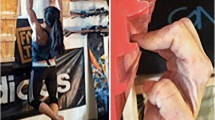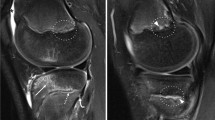Abstract
Objectives
To study the value of 3.0-Tesla magnetic resonance imaging for baseline and follow-up assessment of epiphyseal finger phalanx stress fractures in a collective of 7 consecutive adolescent climbing athletes.
Materials and methods
Baseline MRI was performed in 8 fingers of 7 adolescent athletes (mean age 13.8 years, female:male = 2:5) with clinically suspected stress fracture of the fingers acquired during climbing sports. Follow-up MRI was performed after functional therapy with training interruption for 6 weeks (n = 6) and 12 weeks (n = 1). Images were analysed retrospectively and independently by two readers using an MRI grading score from 0 (no pathology) to 4 (bone marrow oedema and clear depiction of a sharp fracture line with surrounding inflammatory soft tissue reaction).
Results
A total of 8 baseline and 7 follow-up MRIs were analysed. In 7 out of 8 fingers a stress fracture line Salter–Harris III and in all fingers a bone marrow oedema were diagnosed at the epiphyseal base of the middle phalanx. The average grading score was 3.37 in the initial MRI and 1.43 in the follow-up MRI indicating fracture healing in all fingers. Kappa value for interobserver variability was 0.86, representing almost perfect interobserver agreement.
Conclusions
3-T MRI is a promising diagnostic technique for baseline assessment of epiphyseal finger phalanx stress fractures and for follow-up evaluation of fracture healing.


Similar content being viewed by others
References
Hochholzer T, Schoffl VR. Epiphyseal fractures of the finger middle joints in young sport climbers. Wilderness Environ Med. 2005;16:139–42.
Merritt AL, Huang JI. Hand injuries in rock climbing. J Hand Surg Am. 2011;36:1859–61.
Gold GE, Han E, Stainsby J, Wright G, Brittain J, Beaulieu C. Musculoskeletal MRI at 3.0 T: relaxation times and image contrast. AJR Am J Roentgenol. 2004;183:343–51.
Grossman JW, De Smet AA, Shinki K. Comparison of the accuracy rates of 3-T and 1.5-T MRI of the knee in the diagnosis of meniscal tear. AJR Am J Roentgenol. 2009;193:509–14.
Mosher TJ. Musculoskeletal imaging at 3T: current techniques and future applications. Magn Reson Imaging Clin N Am. 2006;14:63–76.
Saupe N, Pfirrmann CW, Schmid MR, Schertler T, Manestar M, Weishaupt D. MR imaging of cartilage in cadaveric wrists: comparison between imaging at 1.5 and 3.0 T and gross pathologic inspection. Radiology. 2007;243:180–87.
Bauer JS, Banerjee S, Henning TD, Krug R, Majumdar S, Link TM. Fast high-spatial-resolution MRI of the ankle with parallel imaging using GRAPPA at 3 T. AJR Am J Roentgenol. 2007;189:240–5.
Chang G, Friedrich KM, Wang L, et al. MRI of the wrist at 7 tesla using an eight-channel array coil combined with parallel imaging: preliminary results. J Magn Reson Imaging. 2010;31:740–46.
Goncalves-Matoso V, Guntern D, Gray A, Schnyder P, Picht C, Theumann N. Optimal 3-T MRI for depiction of the finger A2 pulley: comparison between T1-weighted, fat-saturated T2-weighted and gadolinium-enhanced fat-saturated T1-weighted sequences. Skeletal Radiol. 2008;37:307–12.
Weber MA, von Stillfried F, Kloth JK, Rehnitz C. Cartilage imaging of the hand and wrist using 3-T MRI. Semin Musculoskelet Radiol. 2012;16:71–87.
Sormaala MJ, Ruohola JP, Mattila VM, Koskinen SK, Pihlajamaki HK. Comparison of 1.5T and 3T MRI scanners in evaluation of acute bone stress in the foot. BMC Musculoskelet Disord. 2011;12:128.
Ludescher B, Martirosian P, Lenk S, et al. High-resolution magnetic resonance imaging of trabecular bone in the wrist at 3 tesla: initial results. Acta Radiol. 2005;46:306–9.
Bayer T, Schweizer A. Stress fracture of the hook of the hamate as a result of intensive climbing. J Hand Surg Eur Vol. 2009;34:276–77.
Landis JR, Koch GG. The measurement of observer agreement for categorical data. Biometrics. 1977;33:159–74.
Dobrindt O, Hoffmeyer B, Ruf J, et al. Blinded-read of bone scintigraphy: the impact on diagnosis and healing time for stress injuries with emphasis on the foot. Clin Nucl Med. 2011;36:186–91.
Hodler J, Steinert H, Zanetti M, et al. Radiographically negative stress related bone injury. MR imaging versus two-phase bone scintigraphy. Acta Radiol. 1998;39:416–20.
Krestan C, Hojreh A. Imaging of insufficiency fractures. Eur J Radiol. 2009;71:398–405.
Krestan CR, Nemec U, Nemec S. Imaging of insufficiency fractures. Semin Musculoskelet Radiol. 2011;15:198–207.
Kurock W, Sennerich T. Epiphysenverletzungen beim jugendlichen Sportler. Dtsch Zeitsch Sportmed. 1986;37:53.
Ricci AR, Mason DE. Little league shoulder: case report and literature review. Del Med J. 2004;76:11–4.
Morscher E. Strength and morphology of growth cartilage under hormonal influence of puberty. Animal experiments and clinical study on the etiology of local growth disorders during puberty. Reconstr Surg Traumatol. 1968;10:3–104.
Schweizer A. Biomechanical properties of the crimp grip position in rock climbers. J Biomech. 2001;34:217–23.
Acknowledgements
The authors wish to thank Ms. Katharina Hohmann and Dr. Perminder Singh for English language support.
Conflict of interest
No conflict of interest.
Author information
Authors and Affiliations
Corresponding author
Rights and permissions
About this article
Cite this article
Bayer, T., Schöffl, V.R., Lenhart, M. et al. Epiphyseal stress fractures of finger phalanges in adolescent climbing athletes: a 3.0-Tesla magnetic resonance imaging evaluation. Skeletal Radiol 42, 1521–1525 (2013). https://doi.org/10.1007/s00256-013-1694-4
Received:
Revised:
Accepted:
Published:
Issue Date:
DOI: https://doi.org/10.1007/s00256-013-1694-4




